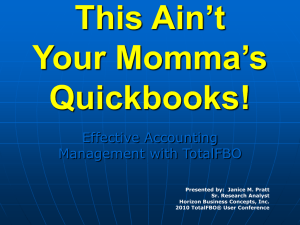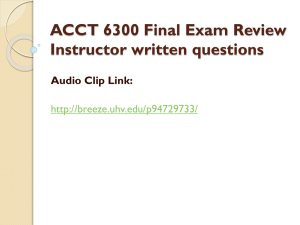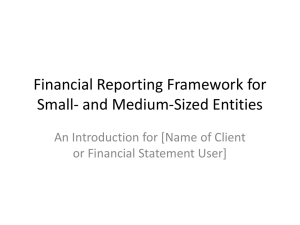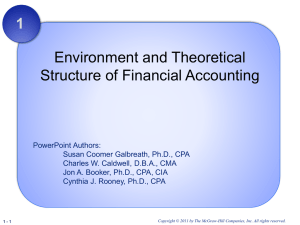The Basics of GAAP, GAAS and Financial Reporting
advertisement
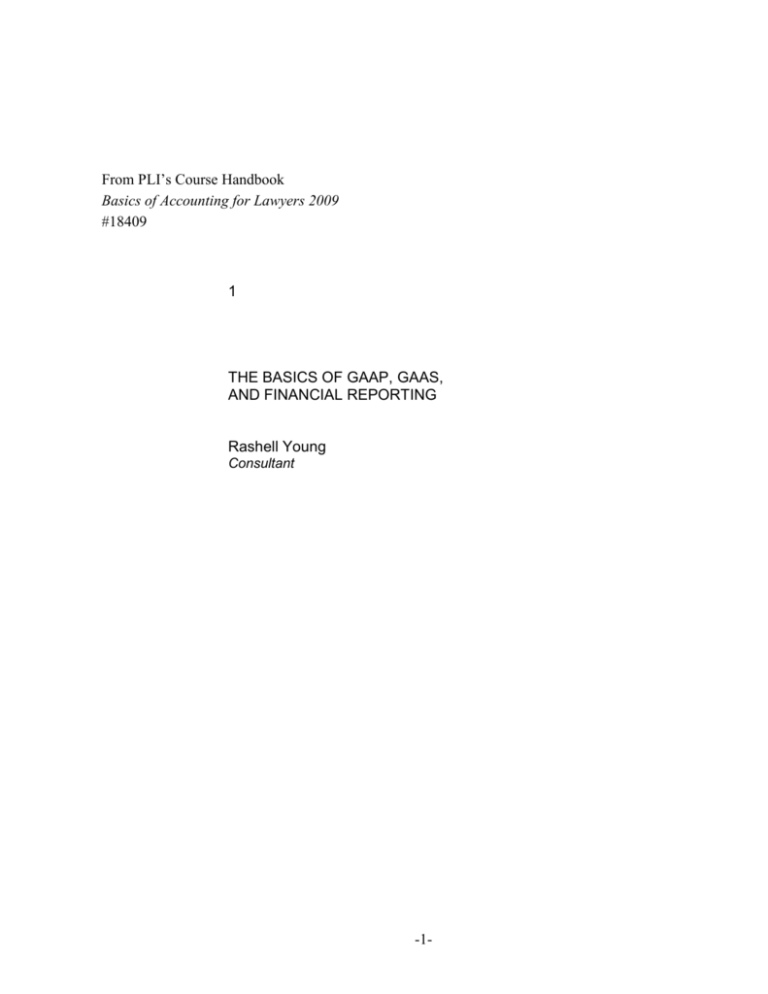
From PLI’s Course Handbook Basics of Accounting for Lawyers 2009 #18409 1 THE BASICS OF GAAP, GAAS, AND FINANCIAL REPORTING Rashell Young Consultant -1- The Basics of GAAP, GAAS, and Financial Reporting By Rashell Young, MBA, MPH Generally Accepted Accounting Principles (GAAP) GAAP provide reporting companies, investors, lenders, and others with a framework that covers both general principles and specific practices. In many areas of legal practice— from mergers and acquisitions to litigation—knowing the basics of financial reporting allows the user to ask intelligent questions and understand where crucial pitfalls may lie. GAAP is the standard framework of guidelines for financial reporting in the United States, compared to international financial reporting standards (IFRS). U. S. GAAP includes the standards, conventions, and rules accountants follow in recording and summarizing transactions, and in the preparation of financial statements. One key aspect of GAAP is an emphasis on "general,” which does allow for some discretion in how rigidly a particular principle is followed. Some observers have called GAAP a “six lane highway” where all lanes are legal, but not the same. In essence GAAP accommodates some variation in applied accounting methods as long as the methods generally adhere to this set of principles. In theory, adherence to GAAP allows investors and other users to make informed decisions about the financial condition of a company. Thirdparties who must rely on financial statements have a right to be confident that the data are free from bias and inconsistency, whether deliberate or not. This requires: 1) Credible information 2) Full and Fair Disclosure 3) Consistency and Comparability between Entities It also requires regularly re-visiting the underlying principles, their use or misuse in the world of financial reporting, and whether the principles require more structure. For the last thirty six years the Financial Accounting Standards Board (FASB) has been the designated quasi-public organization for establishing standards of financial accounting. The Securities and Exchange Commission (SEC) officially recognizes FASB rules as authoritative1, although the SEC has statutory authority to establish financial accounting and reporting standards for publicly held companies under the Securities Exchange Act of 19342. Besides the FASB and the SEC, the other major contributors to GAAP standards and practice include the American Institute of CPAs (AICPA) – a private entity that often address specialized industries or specialized transactions- and the International Accounting Standards Board –another private entity, which provides guidance and promotes the use of international financial reporting standards.3 This public-private partnership has been tested by financial crisis, both the current failures (think Bear Stearns) and past scandals (remember 1 See Financial Reporting Release No. 1, Section 101, and reaffirmation via an April 2003 Policy Statement. See full text at http://www.sec.gov/about/laws/sea34.pdf. 3 For additional information please refer to http://www.iasb.org/Home.htm. 2 -2- Enron). Irrespective of these issues, the long standing reliance on the private sector4 is unlikely to change in the foreseeable future. [Congress recently told the FASB to revise the fair value standards or they, Congress, would do it for them.] What’s also clear from recent and historical events is that adhering to GAAP principles does not always ensure that we have credible information, full and fair disclosure, or consistency and comparability in reporting between entities. This may be true for many reasons ranging from the judgment of management and/or auditors to outright fraud. For instance, when is revenue recognized by a company, and how appropriate or accurate is the matching of expenses to those revenues? There’s some degree of subjectivity to this “matching principle” and it is just one of many areas where we rely on management’s judgment in compiling the financial statements. Usually there’s an honest effort, and internal controls, that lead to fair, though perhaps somewhat subjective, reporting. Of course the auditors, the “GAAP police” evaluate whether the financial statements prepared by management are in accordance with GAAP. In the more extreme example, management may be highly deceptive and supply unreliable information or omit certain material data. One way to try and overcome these types of errors or omissions is in the auditing process. That’s where Generally Accepted Auditing Standards (GAAS) fit in. GAAS is a set of systematic guidelines used by auditors when conducting financial audits on companies' finances. The guidelines are to ensure the i) accuracy, ii) consistency and iii) verifiability of management’s representations. By relying on GAAS, auditors can minimize the probability of missing material information. GAAS are divided into three main sections: 1) General standards. 2) Standards of fieldwork. 3) Standards of reporting. Each section of GAAS has numerous requirements for the company and the auditor. This requires advance planning by both entities. It also requires a high level of independence between the two entities in an effort to have uninfluenced unbiased audit of financial information. As described previously, one of the purposes of the audit is to obtain reasonable assurance about whether the financial statements are free of material misstatement (whether caused by error or fraud).The auditor evaluates whether financial statements prepared by management are fairly presented in accordance with GAAP; and the resulting audit opinion states that the CPA has audited the accompanying financial statements in accordance with GAAS, and that those financial statements present fairly the financial position and results of operations of the audited entity in accordance with GAAP. An audit report is the highest level of assurance the CPA can offer and will clearly state “…the financial statements present fairly an entity’s financial position…in conformity with generally accepted accounting principles…”. 4 Before FASB the Accounting Principles Board (APB) was the principal authority in establishing GAAP. -3- To reiterate, the company’s management has prepared the financial statements (and states that as a part of the expanded disclosure under SOX5), so the audit’s purpose is to verify management's accounting assertions. A few of the areas examined include: – Existence of accounts and information: does what is in the account actually exist? For example, is there really inventory at all the locations in the amounts indicated? – The completeness of the data: have all the transactions for the period been recorded? For example, did all the potential legal expenses get recorded, or have they forgotten to accrue for the boutique firm handling the separation matter? – What is the value of certain items owned by the company: fair value does not apply to all assets and liabilities. A great example today is real estate holdings, which may not be worth what the Company paid for them. – What are the rights and obligations of the company: who really has title, or owes the obligation, at the given point in time? Sometimes, for GAAP purposes, these are not necessarily legal rights – for example, certain leased assets are capitalized on the books of the lessee even though legal title remains with the lessor. – The presentation and disclosure of information: Balances not only must be properly measured but also adequately described and disclosed. Trade (customer) receivables, employee advances, employee loans, and a loan to a related party are all receivables. However, the presentation of each must reflect the individual characteristics of the transactions, because their import to, and implications on, the business can be very different. The procedures used to verify the assertions made by management usually include testing the system, testing transactions, reviewing confirmations, observing physical inventory (usually through a site visit), making inquiries where questions arise. The resulting audit report will state that the financial statements have been audited in accordance with GAAS, and that those financial statements present fairly the financial position and results of operations of the audited entity in accordance with GAAP. In instances in which a portion of the financial reporting seems significantly uncertain, the auditors may include a qualified or modified opinion that essentially states that certain aspects of the report diverge from GAAP. It is worth noting that audited financial statements are not a panacea for errors or judgment contained in a company’s financial reporting. There is still a fair amount of “art” in accounting and reporting. Auditors are allowed and encouraged to use their expertise to decide on the “right” way to report financial information. Given the information and argument, even auditors can miss, miss-represent, issues in a company’s financial position. In a litigation context the audit workpapers can be a key source of information when questions arise. Audit workpapers must contain: – AS3: written record of basis for opinion – Permanent file documentation 5 To read more on Sarbanes Oxley see http://www.sec.gov/rules/final/33-8238.htm#ii. -4- – – – Planning and general information Document detailed systems evaluation, transaction reviews, and internal controls Audit program The audit workpapers can flag issues that may not have been a primary concern during the audit, but when examined with other relevant issues reflect a pattern of behavior. There are a few additional levels of “review” which are less rigorous than an audit. For smaller entities (i.e. limited liability partnerships, limited liability companies, proprietorships) accountants may be engaged to “review” or “compile” (both defined terms) the financial statements for the entity. Nether are subject to GAAS, audits, and audit workpapers will not be prepared for the accountant’s work with these financials statements. A compilation report states that the CPA has compiled the financial statements in accordance with Statements on Standards and Review Services (SSARS); that a compilation is limited to presenting, in the form of financial statements, information that is the representation of management; and that the CPA does not express an opinion or any other form of assurance on them. Note that a compilation report: – Does not have to include footnotes or cash flows, but that limitation must be mentioned in the report; – The CPA does not have to be independent, but that limitation must be mentioned in the report; and – The CPA’s responsibility is to see that the financials are free from obvious material misstatement. A “review” is somewhat more rigorous than a compilation but less than an audit. A review report states that the CPA has reviewed the financial statements in accordance with SSARS. It also states that a review consists principally of inquiries of company personnel and analytical procedures; that a review is substantially less in scope than an audit; and that the CPA is now aware of any material modifications that should be made in order to be in conformity with GAAP. Note that for a review: – The CPA must be independent and – The report must include notes and cash flows. Whether an entity’s financial statements were reviewed, compiled, or audited, indicates the level of work performed by the independent accounants. As with understanding the basics of GAAP, having a grasp of the fundamentals of GAAS can be helpful in a legal practice and will help in asking intelligent questions of your client or accounting expert in any context. As discussed, financial reporting, even under GAAP is subjective. In many ways it is an art that will continue to morph with today’s and tomorrow’s economic climate. In spite of its imperfections, however, financial reporting offers a window into the financial position of an entity. The key to truly understanding financial reporting is recognizing its uses and its limitations. -5- Standard Definitions 404 – Section 404 of the Sarbanes-Oxley Act of 2002. This is the section that requires a publicly-held registrant to document, test, examine and opine on the effectiveness of its system of internal controls. Currently, accelerated filers must do so – and their IRPAF also issues an opinion on the Company’s internal controls as well. Beginning with fiscal years ending after December 15, 2007, non-accelerated filers also submit management’s assessment of the Company’s IC system. The SEC has proposed that two years later, their auditors will also opine on the Company’s IC. AAERs – Accounting and Auditing Enforcement Releases are released by the SEC in connection with enforcement actions brought against registrants and accountants. ACSEC – Accounting Standards Executive Committee. AICPA – American Institute of Certified Public Accountants. AIN – AICPA Accounting Interpretation. AJEs – Adjusting Journal Entries. APB – Accounting Principles Board Opinion. ARB – Accounting Research Bulletins. ASB – Auditing Standards Board of the AICPA. ASR – Accounting Series Release. The ASRs covered a wide range of accounting and enforcement topics, and some are still referred to today. However, in 1982 they were replaced with FRRs and AAERs. CAJEs – Client Adjusting Journal Entries. CD – Control Deficiency. A deficiency in internal control over financial reporting exists when the design or operation of a control does not allow management or employees, in the normal course of performing their assigned functions, to prevent or detect misstatements on a timely basis. CJEs – Consolidation Journal Entries. CMA – Certified Management Accountant. CPA – Certified Public Accountant. EBITDA – Earnings before interest, taxes, depreciation, and amortization. This is a measurement often favored by analysts and investors; interest and taxes are added back as they are often considered outside of the realm of “normal” operations, and depreciation and amortization are added back because they are non-cash items. EDGAR – Electronic Data Gathering And Retrieval system. EDGAR performs automated collection, validation, indexing, acceptance, and forwarding of documents and other submissions by companies and others who are required by law to file forms with the SEC. EDI – Electronic Data Interchange. This is the electronic exchange of information between companies – for example, purchase orders and shipment information. EITF – Emerging Issues Task Force. This is a part of the FASB that deals with “emerging” or unusual issues. Sometimes the issues are strange twists of existing accounting rules; other time, they truly deal with new types of transactions or economic conditions that haven’t been significant previously. EJEs – Elimination Journal Entries. -6- EPS – Earnings Per Share. Very simply (ignoring a lot of potential complications), it’s the amount of profit or loss attributable to each share of stock. FAS – Financial Accounting Standard, or Financial Accounting Series, issued by the FASB. “Financial Accounting Series” appears on the cover page of the pronouncements above “Statement of Financial Accounting Standards No. XX” in actual titles. This term is used interchangeably with SFAS and sometimes “FASB No. XX” in referring to the standards. FASB – Financial Accounting Standards Board. FIFO – First-In, First-Out. This is the most common method of inventory valuation, and assumes that what came in first goes out first. For example, if you buy two widgets at $20 each and then two at $25 each, then sell three of your total, FIFO would say the one that’s left is one of the $25 ones. FIN – Financial Interpretation of the FASB. FRR – Financial Reporting Release. FRRS – the Financial Reporting Releases communicate the SEC’s positions on certain accounting and auditing principles and practices. FSP – FASB Staff Positions. FTB – FASB Technical Bulletins. FV – Fair Value. GAAP – Generally Accepted Accounting Principles. Here, usually means those generally used in the United States (otherwise, specific country should be identified). GAAS – Generally Accepted Auditing Standards. A set of systematic guidelines used by auditors when conducting audits on companies' finances, ensuring the accuracy, consistency and verifiability of auditors' actions and reports. IAS – International Accounting Standard, issued by the IASB. IASB – International Accounting Standards Board. The IASB has been the global standard-setter since 2001, replacing the IASC. IC – Internal Controls. IFRS – International Financial Reporting Standards, issued by the IASB. MD&A – Management’s Discussion and Analysis. MW – Material Weakness. A deficiency, or a combination of deficiencies, in internal control over financial reporting, such that there is a reasonable possibility that a material misstatement of the company's annual or interim financial statements will not be prevented or detected on a timely basis. NRV – Net Realizable Value. Generally represents sales value less costs of disposal. OCBOA – Other Comprehensive Basis of Accounting. GAAP requires accrual-based accounting; common OCBOAs include the cash or modified-cash method of accounting, and the income-tax basis method of accounting. PAJEs – Proposed Adjusting Journal Entries – can also be used for Passed Adjusting Journal Entries. PCAOB – Public Company Accounting Oversight Board. Sometimes called "Peekaboo," the PCAOB is a private-sector, non-profit corporation created by the SarbanesOxley Act of 2002 to oversee the auditors of public companies. Some of its more significant powers include: registering public accounting firms that audit public company issuers; setting auditing, quality control, ethics, independence and other standards relating to the preparation of audited reports; conducting inspections of -7- IRPAFs; and conducting investigations and disciplinary proceedings concerning, and impose appropriate sanctions where justified upon, IRPAFS and associated persons. RJEs – Reclassification Journal Entries. SAB – Staff Accounting Bulletin. “Staff” here refers to the Staff of the SEC. Although technically, pronouncements of the SEC apply only to public company registrants, they tend to “trickle down” to private companies as well. There are very few circumstances a private company would treat an accounting or disclosure item significantly differently from a position recommended by a SAB. SAS – Statement on Auditing Standards. Promulgated by the AICPA, these are the “rules” for auditors of private companies. Additionally, if the PCAOB has not covered a specific topic, auditors follow the SASes. SD – Significant Deficiency. A deficiency, or a combination of deficiencies, in internal control over financial reporting that is less severe than a material weakness, yet important enough to merit attention by those responsible for oversight of the company's financial reporting. SEC – Securities and Exchange Commission. SFAS – Statement of Financial Accounting Standards. SOP – Statement of Position, issued by the AICPA. There are two types – those dealing with accounting matters (for example, SOP 97-2, Software Revenue Recognition), and those dealing with specific auditing/reporting matters (for example, SOP 04-1, Auditing the Statement of Social Insurance). SOX – Sarbanes-Oxley Act of 2002. SSARS – Statements on Standards for Accounting and Review Services, promulgated by the AICPA. XBRL – Extensible Business Reporting Language. XBRL uses a process called “data tagging” to facilitate real-time comparisons of company data with industry averages and peer companies in filings with the SEC. The SEC’s goal is to eventually make the comparisons available to all at no charge through a modernized EDGAR system. -8-



